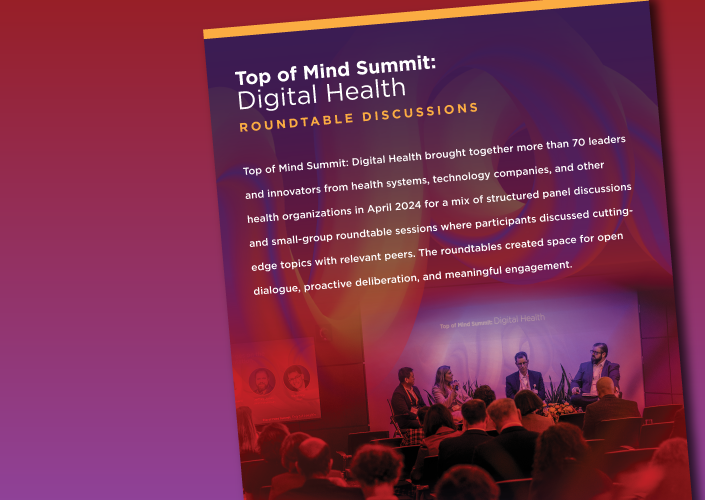Nokia’s Karl Bream discusses ‘The Disruptive Potential of 5G’ in Top of Mind Online keynote
The higher capacity, greater reliability, better performance and security, and low latency of 5G enabled networks will allow hospitals of the future to deliver better patient care more efficiently.
That was the message of “The Disruptive Potential of 5G,” a keynote talk delivered by Karl Bream, Vice President of Strategy, Portfolio, and Alliances at Nokia Enterprise, at the Top of Mind Online virtual summit.
Top of Mind Online, organized by the Center for Connected Medicine (CCM), included six sessions focused on the future of digital health, the role of artificial intelligence (AI) and telehealth in advancing health care, and how health system executives are managing the COVID-19 pandemic, among others.
Bream’s presentation shared examples of how IT networks of the future can help health systems better manage their assets, collaborate on care more effectively and deliver value.
While MRI and CT scanners, infusion pumps, surgical tools, wheelchairs, and other devices within a hospital can’t be replaced with digital copies, Bream said, “we can create significant value and better outcomes by taking digital control of those physical assets.”
“To achieve that level of control, we need to elevate the level of reliability, performance, and predictability of the network across all of the assets in the ecosystem,” Bream said.
That’s where 5G comes in.
“We can create significant value and better outcomes by taking digital control of those physical assets.”
The advantages of 5G for the future of health care
A 5G enabled network is expected to provide better capacity, reliability and performance, security, and latency. A 5G network can deliver 10 times greater capacity, a reliable and secure wireless network indoors and outdoors across a larger area, and an order of magnitude improvement in latency over other forms of wireless communication, Bream said.
“It can reach below 10 milliseconds of latency to as little as one millisecond,” he said. “That happens to be the latency required for autonomous remote-controlled vehicles and drones.”
With 5G, it should be possible for health care to fully realize connected health care that benefits patient care and operations.
For example, with 5G it’s possible to imagine a real-time virtual collaboration space in which remote providers support care for emergency room patients and updates to electronic medical records occur automatically because medical systems, devices and tools are all connected to the network.
Patients would also receive care quickly because facilities of the future monitor patient flow with high accuracy indoor positioning that relieves bottlenecks to increase patient flow and experience.
“The personnel supporting our patient were able to deliver services efficiently because they were no longer spending time looking for missing wheelchairs or misplaced infusion pumps. In fact, leveraging data and AI about the patient, the health system predicted the wheelchair would be required, located it, and scheduled delivery through an automated workflow,” Bream said.
Learn more about the CCM’s Top of Mind program
The CCM’s Top of Mind program focuses on telehealth, artificial intelligence and revenue cycle management through a research report, webinar, virtual roundtables, and a virtual summit. Read about all the components of the program that seeks to examine innovation and digital health priorities in the year ahead.



